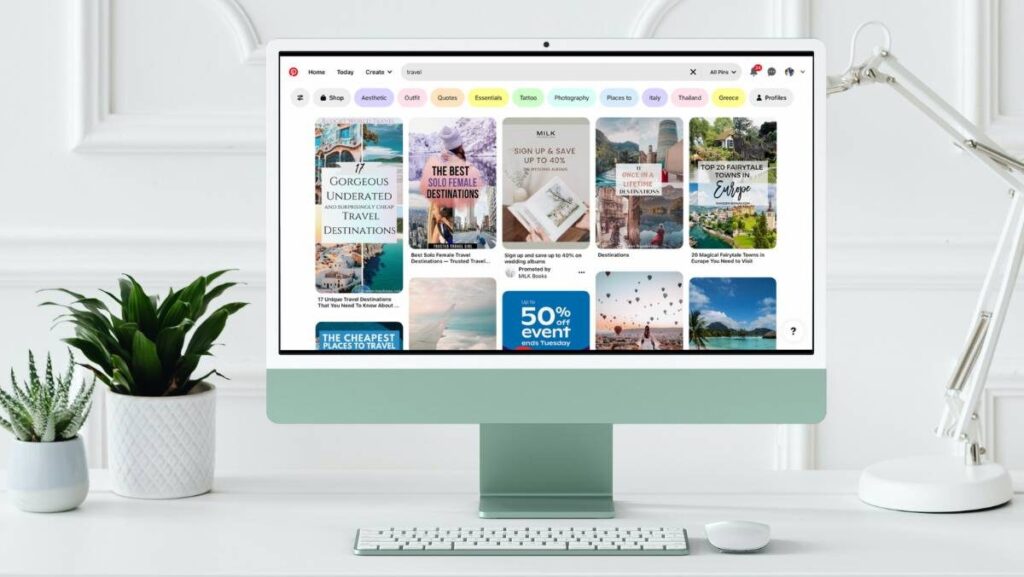By Harriet Barter
Google gets a lot of love in the land of paid media, which leaves many other platforms woefully underappreciated. Pinterest, in our opinion, is one of the best examples of this. Not sure if it’s right for you? We’re here to tell you otherwise.
A place for the positive
Pinterest is not the place for opinions, news, confrontation or any kind of drama. You won’t see any such Wagatha Christie case in court over who outrageously pinned what to which board.
Quite the opposite, Pinterest is purely a place for positivity, inspiration and aspiration. In fact, a study showed 90% of Pinterest users say that the platform is an ‘online oasis’; a place that provides refuge, relief or pleasant contrast to its surroundings. It’s no wonder the platform boasts over 445m global users per month – a population size that would push it ahead of the US as the third largest country in the world if it were a country.
These users flock to Pinterest not for the latest news updates or celebrity mishaps, or for externally motivated reasons. On the contrary, they’re there from an intrinsically motivated perspective, seeking out new ideas and inspiration on how they can better themselves and their lives, be that through new recipes to try, home improvement, travel planning, wedding planning, fashion and beauty, health, self-development – the list is endless.
Pinners have a purpose
When was the last time you ‘accidentally’ ended up on Pinterest? We’ve all been there – picked up our phone, unlocked it, and muscle memory knows exactly where your Instagram or TikTok app is located. You suddenly realise you’re mindlessly scrolling through content without even really knowing how you got there or why you’re there. ‘Doom scrolling’, if you will. The act of spending an extended length of time on social media with no purpose, as opposed to actively engaging with content.
I’m going to hazard a guess that this doesn’t often happen for you with Pinterest. Pinterest probably isn’t an app or website you visit daily either.
This is because Pinners have a purpose. Users on average are using the site on a weekly basis as opposed to daily (or hourly!) like some other platforms, and they have a reason for being there.
They’re actively looking for something, to save something to a board, to feel inspired, to enhance certain areas of their life. This mindset is a goldmine for advertisers who need not worry about content being scrolled past because the user cares more about dog videos than branded content.
Pinners are planners
Pinners are on the platform to plan, so if you can reach them before your competitors do, you’re quids in.
To provide a sense of the mentality of Pinners versus other platforms, Pinterest uses this handy analogy:
- Past: Facebook, Instagram
“That was a super fun party”
- Present: Twitter, Snapchat
“Look, I’m at a super fun party”
- Future: Pinterest
“I am planning the best, most fun party”
While other platforms are concerned with the past and present, Pinterest is all about tomorrow. This means brands can reach users in discovery mode, when they’re actively open to new ideas and therefore highly receptive to advertiser content – provided you’ve nailed the creative.
In fact, 97% of searches on Pinterest are unbranded; and from 445m monthly users, that’s a LOT of non-brand-loyal people potentially looking for what you have to offer. Pinners are open-minded and undecided – this is a brilliant chance for you to go get ‘em with your brand.
Last year, Pinterest also dived further into the commerce sphere with developments of a Shopping API, allowing advertisers to directly link their product feeds – so there’s tons of opportunity.
Men are joining the pinning party
‘But Pinners are all just women looking for inspo for their next hair cut or what shirt pairs best with their new trousers!’ I hear you cry.
Wrong.
Whilst these may have been a few of my own recent searches (guilty), the Pinterest user base is evolving. It is true that women still over index on Pinterest, accounting for over 60% of the user base, but men are on the up. Gen Z men in particular. Male pinners are up 40% year on year, and millennial pinners have increased 35% (in the US) on last year’s numbers.
Pinners are willing to spend
Shoppers on Pinterest typically have 30% larger baskets at checkout than through other social platforms. Plus, recent stats released show 45% of people in the US with a household income of over $100k are on Pinterest.
So not only are Pinners in the mood to browse and discover brands, they are looking to actively buy – often quite a lot!
Pins are the gifts that keep on giving
And finally, longevity. Unlike other social media platforms where posts can have a short term lifespan, Pinterest can continue to drive traffic (and sales) long after pins is first posted. This makes it an increasingly valuable platform for brands looking to generate long-term impact from their content.
So, in short, Pinners are actively searching with a purpose for positive content, are in the discovery and planning phase of their journey, are willing to spend money, and are not searching for brands.
The question isn’t ‘Should you be advertising on Pinterest?’, the question is ‘How can you justify not advertising on Pinterest?’
Want to talk to one of our team about the opportunities on Pinterest? Get in touch today.

